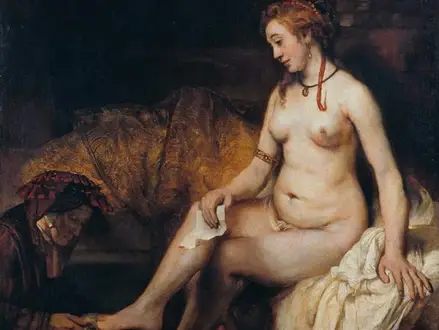Title of Artwork: “Bathsheba at Her Bath (Bathsheba Holding King David’s Letter)”

Artwork by Rembrandt
Year Created 1654
Summary of Bathsheba at Her Bath (Bathsheba Holding King David’s Letter)
Artwork by Rembrandt depicting Bathsheba bathing and receiving the letter from King David was completed in 1654 and is known as Bathsheba with King David’s Letter.
All About Bathsheba at Her Bath (Bathsheba Holding King David’s Letter)
Sultry and tender, this painting depicts a moment from the Bible’s story of King David’s encounter with Bathsheba in the bath and his subsequent seduction and rape of her. When David wants to marry Bathsheba, he sends her husband into battle and orders his generals to abandon him, putting him in a position of death.
It has been depicted by other artists, but Rembrandt stands out because of its tight focus and erotic vitality, achieved through thick, vibrant brushstrokes and broad, thick brushwork.
Dr. Louis La Caze donated 583 works to the Louvre in 1869, and this painting is one of them. Kenneth Clark describes the canvas as “Rembrandt’s greatest painting of the naked” (his words). Some have called this painting ‘one of the great achievements of western painting.’
Second Book of Samuel (11:2-4) tells the story of King David who witnessed a woman bathing from the roof of his palace. To his surprise, he learned that she had been named Bathsheba, the daughter of Eliam and the wife of Uriah the Hittite, when he inquired about her.
The messengers of David were sent to bring her back, and after they had sex, she became pregnant with his child. Because of the death of Uriah in battle, David was able to wed Bathsheba.
As a standard practise, Bathsheba had been depicted as bathing in the open air, accompanied by maids, prior to Bathsheba at Her Bath. There was often a tower in the distance, sometimes with a small figure of David and his two courtiers.
The Toilet of Bathsheba, by Rembrandt, was based on this design. By omitting David, his messengers, and most of the traditional narrative elements from the picture—the only anecdotal references included are the letter from David (not actually mentioned in Samuel), and the presence of an attendant drying her foot—presentation Rembrandt’s of Bathsheba is both intimate and monumental.
There’s no longer any emphasis on David as voyeur; instead, the direct eroticism of the viewer’s perspective replaces it entirely.
Unlike any previous depiction of the scene, Bathsheba dominates the painting in a life-size and shallow space. It is not known if Rembrandt painted Bathsheba for his own reasons or to fulfil a specific request.
Willem Drost, Rembrandt’s former pupil and close associate, painted Bathsheba with David’s Letter in the same year as Rembrandt’s painting, which is in the Louvre.
Anecdotal devices are absent, but the painting is still unusual in other ways. It is difficult to read the space Bathsheba is placed in. A large column in the foreground suggests a large architectural structure, while the dark background suggests night.
Behind her, a passageway of golden-hued drapery is draped in browns and ochers. Naked skin contrasts with an intricately painted white chemise, and the sumptuous application of paint makes it stand out even more. Her body is given a vibrant tactile quality by the broad brushstrokes and strong highlights used to describe her figure in the painting, making her presence obvious.
Information Citations
En.wikipedia.org, https://en.wikipedia.org/.

























